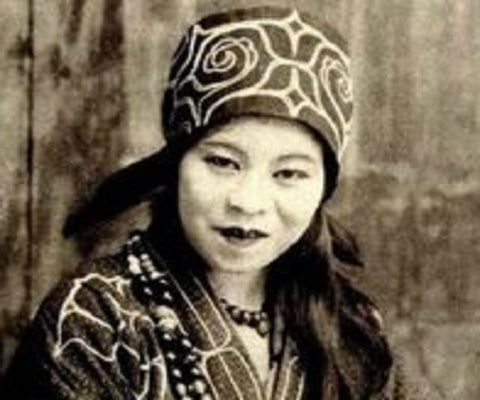Empress Wu is the only recognized female Emperor in all of Chinese history, and the first of only two women to wear the yellow robes of the Emperor.
*Note to the Reader: Some of the people in this story have names that are very similar or identical in written English. Thus, we refer to such people mostly by their titles and position*
From Lavish Beginnings
Wu Zetian was born in the same year as a total solar eclipse seen across China. Her father was a successful businessman, and her mother was from a powerful family. Li Yuan, a future Emperor, was close to the Wu family, and on his accession granted her father many senior managerial roles.
Because Wu’s family was so well-off, she was not expected to do the menial labor that women normally did. So, while the servants did the work, she had to find something else to occupy her time. Luckily for her, her father, unlike most men, encouraged her to read and develop an education, and luckily for him, she proved quite capable and interested.
At the young age of 14, she was taken as an imperial concubine. Because of her ability to read and write, she became a type of secretary as well. While she did not seem to be much favored by the Emperor (only rank 5 out of 9), she did manage to attract the eye of one of the Emperor’s sons, and the two of them had an affair.
The Emperor died, and, as Wu had not had any children by him, she was consigned to a monastery to live out the remainder of her life. Fortunately for her, the prince she had an affair with, due to two disgraceful older brothers, ended up becoming the next Emperor, even though he was the youngest son. One day, the former prince came to offer incense to the late Emperor, saw her and remembered. His Empress Wang was there too and saw his reaction. Now, Empress Wang was not highly favored by the Emperor, who preferred Consort Xiao to Empress Wang. Hoping that the arrival of a new concubine would distract the Emperor from Xiao, Wang told Wu to clean up and brought her back to the palace as a new concubine.

To the Top
Within a few years, Wu was of the first rank of concubines. As time passed, the Emperor favored her more and more. When Wang and Xiao, who had been rivals, combined forces to counter this rising threat, it was too late and cost them dearly.
Wu was not one to take challenges to her power lying down. By this point Wu had had two sons and a daughter by the emperor. Soon after, Wu’s daughter died in suspicious circumstances, and Wang was framed, with Wu accusing Wang and her family of using witchcraft to kill the child. (Because of Wu’s later ruthlessness, some think she deliberately murdered her own daughter to remove Wang as a rival.) Wang had no children, and the Emperor used this as a convenient excuse to depose her. Wu took Wang’s place as the new Empress.
Wu stayed busy behind the scenes. During the following year, the heir apparent was changed from Xiao’s oldest son to Wu’s. The next year saw many officials who had spoken out against Wu’s replacement of Wang being exiled to remote provinces or killed. 3 years after that, and Xiao’s oldest son was arrested and exiled as well. Also, during this time, the Emperor began to suffer from a debilitating illness. Wu proved capable of helping with state affairs, and, over time, began to make more and more decisions for the Emperor until they were considered equal in power.

Eliminating the Competition
This continued for 4 years, and, eventually, the Emperor himself began to see Wu as a threat. He asked a servant for advice, and the servant suggested that he depose Empress Wu. The Emperor had that servant draft an edict deposing Wu as Empress. Wu got wind of this and managed to arrive in person and plead her case. The Emperor, always having a soft spot for Wu, could not go through with it. Unfortunately for the servant, the Emperor chose to blame him to save face. Furthermore, the servant had served on the staff of Xiao’s oldest son, the former heir-apparent. Wu used this fact to link the servant with the former heir in a fabricated treasonous plot, causing the servant to be executed and the former heir to commit suicide.
Wu was intensely loyal to her mother (to whom the Emperor had lavished great honors, as well as to Wu’s late father), but not to anyone else in the family. The Emperor decided to honor Wu’s older sister and her two brothers. The brothers mentioned that they did not feel they deserved to receive the posts based solely on their relation to Empress Wu. Wu’s mother was not happy, so Wu, in order to avenge her mother’s unhappiness, saw fit to exile her brothers to remote provinces. Wu’s older sister had attracted the attention of the Emperor, and he considered taking her to the palace as another concubine. Wu got wind of this and had her older sister poisoned and accused her brothers of doing it! Thus, with one stroke, she got rid of her siblings. After Wu’s mother died a few years later, her older sister’s son made it clear he suspected Wu of killing his mother. Wu had him accused of dishonoring her mother’s memory and raping the daughter of an official. He was then exiled and there eventually died.
The Death of Sons
The Emperor’s health eventually deteriorated enough that he considered making her regent. However, he reconsidered when two officials advised against it. Empress Wu continued eliminating all rivals. The Emperor had shown favor to his aunt, whose daughter was married to Wu’s third son. So, Wu had her own daughter-in-law arrested and starved to death. Her first son, the heir, urged her to not take so much power to herself, and to allow his half-sisters, the daughters of Consort Xiao to marry. Wu poisoned her son and his half-sisters quickly died. Two more of the Emperor’s sons were accused of crimes and demoted.
Li Xian, her second son, became heir-apparent. He heard some (untrue) rumors that he was not Wu’s son but Wu’s older sister’s and began to question his heritage. Li also had a sorcerer that both Wu and the Emperor respected killed (probably because the sorcerer said he was not fit to be Emperor). So, Wu had him accused of treason and planted a large number of weapons at his residence to back up her claim. He was deposed and exiled, making his younger brother the new heir.
Around 8 years past, and the Emperor died. Her third son Li Zhe took the throne, and Wu became Empress Dowager, the official title of the mother of the Emperor. The late Emperor had written in his will for his son to take immediate power on his death and look to Wu for advice. His son did the first part, but not the latter, instead being controlled by his wife. He was caught wondering aloud if it would be bad to just give the Empire to his father-in-law. This was reported to Wu, and she took quick action, deposing her son and installing her fourth-and-youngest son as the new Emperor. Wu took this time to execute her still-exiled second son.
Emperor in Truth
By this time, Wu was done with appearances. While it was customary for the regent to still have the too-young-to-serve Emperor issue commands, even if they were crafted by the regent, Wu did away with this and just issued them herself. The new Emperor never even got to move to the Imperial Suite, instead living in basic house arrest. At one point, she offered to turn the Empire over to him, but at this point, fully aware of who she was, the “Emperor” declined to take power. 4 Years later, and she disposed with all pretense, taking the throne for herself and founding her own dynasty.
She was a great and terrible ruler. Not terrible as in bad, she was eminently capable, as acknowledged by even her fiercest critics, but as in terrifying. She had a secret police force that helped her take total control over the government. In a far-off province, one of her exiles started a rebellion, and the same official who had told her of her son’s musing of turning over the Empire suggested she step down, as that should quell the rebellion. He had apparently forgotten whom he was talking to and was summarily executed, along with all those who tried to defend him.
Her Empire began to corrode from within due to her constant paranoia of losing power. Her secret police force was used by some unscrupulous men to gain power, making false arrests and executions in the name of maintaining order. She summoned officials, but they were afraid of being falsely accused and executed, so they started a rebellion. However, they did not coordinate very well, causing Wu’s forces to easily crush them. Ironically, their very fear caused the thing they dreaded: their executions.
Wu’s deeds are too numerous to account, and most of them are quite interesting. However, we do not have the space to recount them all here. Suffice it to say, they followed much in the vein of what we have already told, with much terror, executions, paranoia, more executions, and, through it all, remarkable competence.

Losing the Empire
Toward the end of her reign, Wu was getting old, and two of her nephews were pressuring her to name one of them as her successor. However, her chief adviser thought the heir should be someone descended from the late Emperor instead and advised Wu to recall her third son Li Zhe from exile. Wu changed the successorship from the Emperor-turned-crown prince back to Li Zhe.
Wu began to think of what would happen to the Empire after her death and foresaw a coming conflict between the Wu clan and the heir-apparent. To try and prevent this, she had them swear an oath for peace. Wu had fallen in love with two brothers, and as she grew older, their power waxed greatly, for she relied on them to handle an increasing amount of matters of state. When her grandchildren saw this and began discussing it amongst themselves, one of the brothers found about it and told Wu; as punishment she had her grandchildren commit suicide.
The brothers began to worry what would happen to them if Wu died, so they falsely accused some of their rivals who were top officials and advisers of Wu. They persuaded one of the servants of the accused to help them, but when he got before Wu to give witness, he told the truth. Wu still exiled the accused but did not kill them.
The brothers and their brothers were accused of corruption, so Wu demoted the brothers’ brothers, but the two she was close to she did not. She began to fall ill, and only the two were allowed to see her, even though her advisers asked her to see only her sons instead. Wu eventually allowed one of her officials to investigate the corruption charges but rendered the investigation superfluous by pardoning one of them.
As her health declined, a coup was formed. Men who were loyal to the heir Li Zhe killed the two brothers, then forced her to yield the throne to him. Her son still honored her, and she was allowed to live in a palace. When she died, he had her entombed with his father.
*Because of the disputed historicity of some of the events, liberties were taken in order to tell a cohesive story.*
See our Chinese Swords >
source
https://www.bladespro.co.uk/blogs/news/wu-zetian-sole-female-chinese-emperor












































